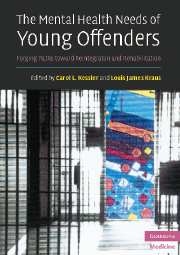Book contents
- Frontmatter
- Contents
- List of contributors
- Foreword
- Acknowledgments
- 1 An overview of child and adolescent mental health needs in the juvenile justice system
- 2 Psychiatric disorders of youth in detention
- 3 Disproportionate minority confinement
- 4 Police interrogation of youth
- 5 Assessing children's competence to stand trial and to waive Miranda rights: new directions for legal and medical decision-making in juvenile courts
- 6 The etiology of antisocial behavior: biopsychosocial risk factors across development
- 7 Substance abuse in youth offenders
- 8 Suicide and delinquent adolescents
- 9 Juvenile sex offenders
- 10 Educational needs of youth in the juvenile justice system
- 11 Science and the juvenile death penalty
- 12 Medical issues regarding incarcerated adolescents
- 13 Mental health screening and assessment in juvenile justice
- 14 Psychological testing in juvenile justice settings
- 15 Psychopharmacology and juvenile delinquency
- 16 Evidence-based treatment for justice-involved youth
- 17 Community alternatives to incarceration
- 18 Innovative problem-solving court models for justice-involved youth
- 19 Ethical issues of youthful offenders: confidentiality; right to receive and to refuse treatment; seclusion and restraint
- 20 Post-adjudicatory assessment of youth
- Index
- References
9 - Juvenile sex offenders
Published online by Cambridge University Press: 11 August 2009
- Frontmatter
- Contents
- List of contributors
- Foreword
- Acknowledgments
- 1 An overview of child and adolescent mental health needs in the juvenile justice system
- 2 Psychiatric disorders of youth in detention
- 3 Disproportionate minority confinement
- 4 Police interrogation of youth
- 5 Assessing children's competence to stand trial and to waive Miranda rights: new directions for legal and medical decision-making in juvenile courts
- 6 The etiology of antisocial behavior: biopsychosocial risk factors across development
- 7 Substance abuse in youth offenders
- 8 Suicide and delinquent adolescents
- 9 Juvenile sex offenders
- 10 Educational needs of youth in the juvenile justice system
- 11 Science and the juvenile death penalty
- 12 Medical issues regarding incarcerated adolescents
- 13 Mental health screening and assessment in juvenile justice
- 14 Psychological testing in juvenile justice settings
- 15 Psychopharmacology and juvenile delinquency
- 16 Evidence-based treatment for justice-involved youth
- 17 Community alternatives to incarceration
- 18 Innovative problem-solving court models for justice-involved youth
- 19 Ethical issues of youthful offenders: confidentiality; right to receive and to refuse treatment; seclusion and restraint
- 20 Post-adjudicatory assessment of youth
- Index
- References
Summary
Definition
A juvenile sex offender can be defined as a youth who commits a sexual act upon a victim without consent, against the person's will, or in an exploitative, threatening, or aggressive manner. Due to variations in county, state, and federal statutes, what legally constitutes a sex offense or offender in one jurisdiction may not hold for another. Likewise, the sexual actions of minors in different countries will be acceptable or not depending on prevailing laws, culture, and local customs. Thus, it is important to consider the historical and cultural setting in which sexual offenses occur. For example, in some cultures masturbation is considered deviant.
Historical comment
Given the magnitude of juvenile sexual offenses and the toll they take on society, it is surprising they were not consistently taken seriously until at least the 1970s. Prior to that time the offenses were often regarded as exploratory, temporary behaviors that would resolve with age (Ryan & Lane, 1997). Other changes took place in the 1970s: civil and criminal statutes addressing sexual offenses were broadened, the accumulation of research on adult sex offenders began to accelerate, and adolescent sex offender programs were developed (Ryan & Lane, 1991). However, by the early 1980s there were still few studies of adequate sample size addressing the success rates for managing youths' sexually deviant behavior (Mayer, 1988).
Keywords
- Type
- Chapter
- Information
- The Mental Health Needs of Young OffendersForging Paths toward Reintegration and Rehabilitation, pp. 198 - 228Publisher: Cambridge University PressPrint publication year: 2007



